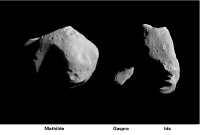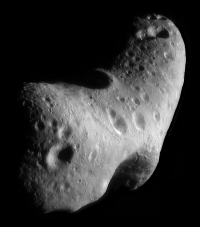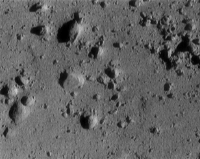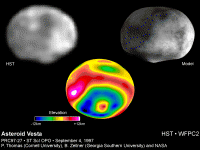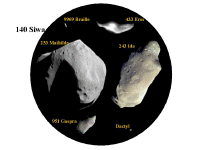Individual asteroids
Asteroids visited by spacecraft
Average distance from Sun (million km)
Individual asteroids
 Asteroids visited by spacecraft
Asteroids visited by spacecraft
This image shows three main-belt asteroids that have been visited by spacecraft. The Galileo spacecraft imaged Gaspra and Ida; the NEAR Shoemaker spacecraft imaged Mathilde. The asteroids are shown to scale.
951 Gaspra
The first asteroid to be visited by a spacecraft. On 29 October 1991, NASA's Galileo spacecraft encountered it near the inner edge of the main-belt asteroids, between Mars and Jupiter. The spacecraft passed about 1600 kilometres from Gaspra at a relative speed of 8 kilometres per second. The pictures revealed a cratered, irregularly shaped body, which measures about 19 by 12 by 11 kilometres. Astronomers have identified more than 600 craters on Gaspra, the largest of which is about 1.5 kilometres across. It is also covered by numerous small fractures. Gaspra is a member of the Flora family of main-belt asteroids, all sharing a similar orbit.
243 Ida and Dactyl
Ida was the first asteroid shown to have a tiny moon, Dactyl. The Galileo spacecraft visited it on 28 August 1993, when it flew within 2400 kilometres of the asteroid. Ida is about 58 by 23 by 21 kilometres, which is much larger than Gaspra, while Dactyl is a mere 1.5 kilometres across. Ida's average distance from the Sun is 428 million kilometres (nearly three times the Earth's distance from the Sun). Similarly to Gaspra, it is heavily cratered and probably composed of silicate material in the form of rocks. Ida also has a scattering of large boulders and is probably covered with a deep layer of fine material. Both Ida and Gaspra are considered common S-type (silicate) main-belt asteroids. Surprisingly, Dactyl, which orbits only 100 kilometres from Ida, appears to be made of materials that are different from those of its large neighbour. This perhaps indicates that the pair did not form together but that Ida's gravitational field captured Dactyl.
253 Mathilde
The largest asteroid so far visited by a spacecraft, Mathilde is 52 kilometres in diameter, which is much larger than Gaspra. On 27 June 1997, NASA's NEAR Shoemaker satellite made a 25-minute fly-by of Mathilde and took more than 500 images of this unusual world. Until then, little was known about Mathilde. Discovered in 1885, it is one of the blackest objects in the Solar System, reflecting only 3% of the light that strikes its surface. Its rotation period of 417 hours is one of the longest known so far. Mathilde is a C-type (carbon-rich) asteroid and it has a very low density, only 30% greater than water. This suggests that it is extremely porous. Some scientists believe it is little more than a giant rubble pile. It has huge craters, with at least four that exceed Mathilde's average radius!
9969 Braille (1992 KD)
Deep Space 1 returned only distant images of this asteroid. The images show that 9969 Braille is very dark and possibly similar in composition to the large asteroid Vesta. It may be a piece that broke away from Vesta during a past collision.
433 Eros
Close-up images from the NEAR Shoemaker spacecraft show a peanut-shaped object with a maximum diameter of 33 kilometres. This makes it much larger and more massive than the object that struck the Earth 65 million years ago and destroyed the dinosaurs. The asteroid's density is 2.4 times greater than water.
While NEAR Shoemaker was in orbit around Eros, the asteroid was too close to fit entirely in the camera's field of view. To achieve a complete view of the surface from a particular vantage point, astronomers took a collection of images and assembled them in a mosaic. To do this, the digital images returned by the spacecraft were draped over a computer model of the asteroid's shape (NASA/NEAR/The Johns Hopkins University).
NEAR Shoemaker also revealed numerous craters and a large depression known as 'the saddle' on Eros. Although the number of giant craters on Eros is not as large as on Mathilde, there are noticeably more than were seen on Gaspra. This means that Eros has an older surface than Gaspra because Eros has been exposed to bombardment by other asteroids for a longer period of time, producing more craters. Also, numerous boulders litter the scarred surface.
NEAR Shoemaker's image of asteroid 433 Eros, taken from a range of 250 metres. The image is 12 metres across and the cluster of rocks in the upper right-hand corner measures 1.4 metres across. Different rocks and boulders are partially buried by other shattered material on the surface of the asteroid. Image courtesy of the NEAR Project (JHU/APL).
NEAR Shoemaker's cameras have also revealed nearly parallel markings, chains of small craters or pits, and grooves. One interpretation is that Eros has a layered internal structure, produced when the asteroid was part of a much larger parent body, and this parent broke up long ago in a gigantic collision.
2685 Masursky
On 23 January 2000, the Cassini spacecraft observed this main-belt asteroid from a distance of 1.6 million kilometres. The images indicate that the asteroid is roughly 15-20 kilometres across. It is probably an S-type object. The asteroid is named after the renowned planetary geologist, Harold Masursky (1923-1990).
Asteroid vital statistics
428 |
396 |
218 |
330 |
350 | |
4.84 |
4.31 |
1.76 |
3.29 |
3.58 | |
Maximum length (km) |
58 |
66 |
33 |
19 |
2.2 |
Rotation period (hrs) |
4.63 |
417.7 |
5.27 |
7.04 |
- |
Orbital inclination (degrees) |
1.14 |
6.71 |
10.83 |
4.10 |
29.0 |
Orbital eccentricity |
0.045 |
0.266 |
0.223 |
0.174 |
0.434 |
Asteroid type |
S |
C |
S |
S |
- |
Year of discovery |
1884 |
1885 |
1898 |
1916 |
1992 |
 Other famous asteroids
Other famous asteroids
1 Ceres
This is the first asteroid ever discovered. An Italian astronomer, Giuseppi Piazzi, found it in 1801. It is about 930 kilometres across and accounts for more than a quarter of the mass of all the main-belt asteroids combined. It takes 4.6 years to go once around the Sun.
4 Vesta
Vesta was the fourth asteroid to be discovered, in 1807. With a diameter of about 510 kilometres, it is by coincidence, the fourth largest asteroid after 2001 KX76, Ceres and Pallas. Vesta is the brightest asteroid and visible with the naked eye. Observations by the Hubble Space Telescope have shown that Vesta has a large circular hollow, probably an impact crater, near its south pole. The 460 kilometre-wide basin is about 12 kilometres deep and has a pronounced central peak. The asteroid is probably made of basaltic material, similar to the rock commonly found in lava flows on the Earth and Moon. This suggests that it was once completely molten.
An image of the asteroid Vesta, taken in May 1996, using the ESA Faint Object Camera on the Hubble Space Telescope. The asteroid was then 110 million miles from Earth. The map shows that the southern pole is dominated by a depression (blue) which is thought to be a large impact feature.
2060 Chiron
Discovered in 1977 by Charles Kowal, Chiron spends its entire life in the outer Solar System, between the orbits of Jupiter and Neptune. Chiron was the first member of a group that astronomers now realise is a family of objects known as Centaurs, all found in similar orbits. Astronomers were surprised in 1989 when Chiron suddenly developed a coma (a cloud of gas and dust). This comet-like behaviour earned it the description Comet 95P/Chiron, while retaining its asteroid status. It is grey in colour and has a diameter of about 200 kilometres.
3200 Phaethon
Discovered in 1983 by the IRAS satellite, Phaethon is about 6 kilometres across and follows a highly elliptical, Earth-crossing orbit. Astronomers think it may be the source of the dust particles that produce the Geminid meteor shower each December. It may be the 'dead' nucleus of an old comet.
1862 Apollo
Discovered in 1932 by K. Reinmuth, this 1.4 kilometre-wide object was the first asteroid found to follow a path that crossed the orbit of the Earth. Astronomers have discovered hundreds of Apollo-type asteroids since then.
 Rosetta's asteroid fly-bys
Rosetta's asteroid fly-bys
During its nine-year trek to Comet Wirtanen, ESA's Rosetta spacecraft will encounter two main-belt asteroids. However, the choice of asteroids has changed because the mission has been refined. Early plans included fly-bys of the S-class asteroid 3840 Mimistrobell and B-class asteroid 2530 Shipka. Instead of the Shipka asteroid, Rosetta will make a fly-by of another S-class asteroid, 3840 Rodari. Eventually, after further studies of possible fly-by candidates, the final change to the schedule was made in early 1999.
Asteroids come in different shapes and sizes
In the current plans, Rosetta will visit two contrasting objects: 140 Siwa, the largest asteroid ever encountered by a spacecraft, and (apart from Dactyl), 4979 Otawara, the smallest.
140 Siwa
With a diameter of around 110 kilometres, Siwa is much larger than any asteroid so far examined by spacecraft. Spectral studies indicate that it is a black, primitive C-type object, which has probably been less altered by collisions than its smaller cousins. Its light curve is rather complex, so figures for its rotation period vary between 18.5 and 22 hours.
Rosetta will obtain spectacular images and high-resolution data as it flies to within 3500 kilometres of Siwa on 24 July 2008. The spacecraft will fly past at a velocity of 17.04 kilometres per second, approaching the sunlit side and looking at a crescent phase as it moves away. At this time, Siwa will be located 2.75 AU (411 million kilometres) from the Sun and 3.11 AU (465 million kilometres) from the Earth, so signals from the spacecraft will take 26 minutes to reach ground stations.
4979 Otawara
Rosetta's fly-by of Otawara will take place on 11 July 2006, when the asteroid is 1.89 AU (about 283 million kilometres) from the Sun. Travelling at a relative velocity of 10.63 kilometres per second, the spacecraft will pass by Otawara's sunlit side at a distance of about 2200 kilometres.
Apart from its orbit, very little was known about Otawara until recent ground-based studies to learn more about its physical and chemical make-up. Astronomers obtained observations during an international campaign using telescopes in France, Chile, and the United States.
The results indicate that Otawara may belong to one of two asteroid types. It may be a fragment of the large asteroid 4 Vesta, and therefore a V-type asteroid, or an S-type object rich in minerals such as pyroxene and olivine. If the asteroid is quite dark, its diameter is probably only 2.6-4 kilometres. Although its density is not known for certain, it is probably 2-2.5 times greater than water, that is, denser than Mathilde but possibly similar to Ida.
Studying changes in its reflected light, known as its light curve, indicates that Otawara rotates quite quickly, once every 2.7 hours. This is faster than any asteroid so far visited by a spacecraft. For astronomers, this rapid spin during Rosetta's fly-by will be an advantage. It will enable Rosetta's instruments to image and measure the asteroid's characteristics at high resolution during one complete rotation.
Most of the orbiter's instruments will be collecting data during the fly-bys. About three weeks before the Siwa encounter, the Virtis multispectral imaging system and Osiris cameras will start taking daily images to aid navigation and provide preliminary information on the nature of the asteroid. Other instruments will be turned on around the time of closest approach.
The precise fly-by scenario at Otawara has yet to be decided.
Rosetta's asteroid targets: vital statistics
Otawara |
Siwa | |
Average distance from Sun (million km) |
324 |
409 |
Orbital period (yrs) |
3.19 |
4.51 |
Estimated size (km) |
2.6 - 4 |
110 |
Estimated rotation period (hrs) |
2.7 |
18.5 |
Orbital inclination (degrees) |
0.91 |
3.19 |
Orbital eccentricity |
0.144 |
0.215 |
Asteroid type |
V or SV |
C |
Date of discovery |
2 August 1949 |
13 October 1874 |
Name of discoverer |
K. Reinmuth |
J. Palisa |

